Rút gọn mệnh đề quan hệ (Relative Clause Reduction) trong tiếng Anh
Rút gọn mệnh đề quan hệ là một chủ điểm ngữ pháp không dễ nhưng rất hữu ích vì giúp câu văn ngắn gọn tự nhiên và rõ ràng hơn. Để làm đúng bạn cần nắm một số quy tắc...
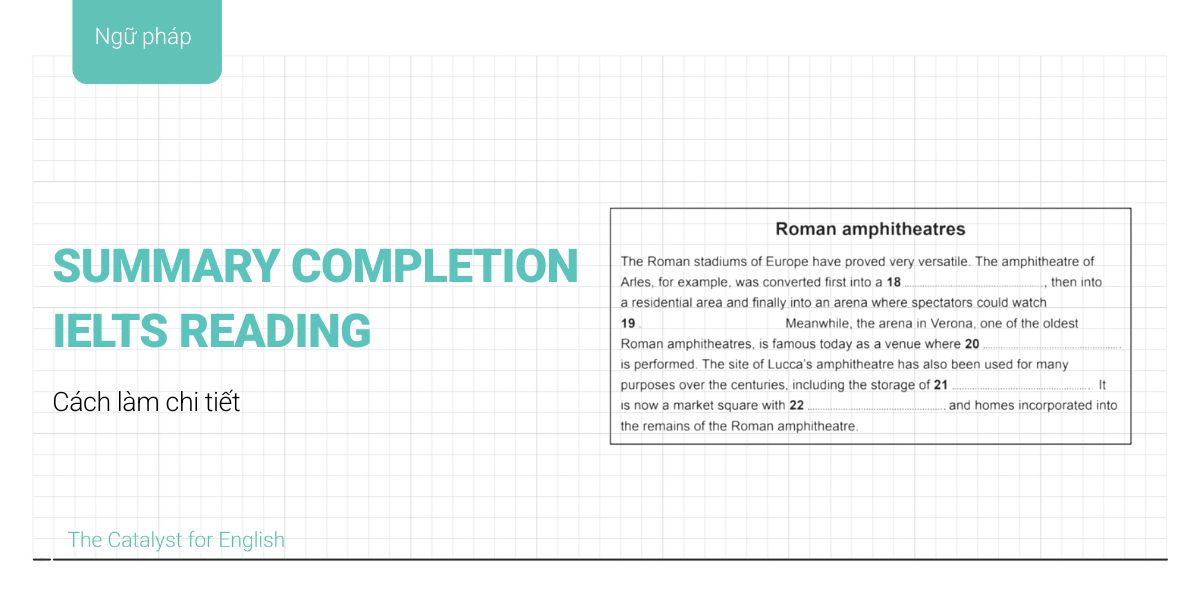
Summary Completion IELTS Reading là dạng bài có tần suất xuất hiện khá cao và do vậy là một trong những loại câu hỏi phổ biến trong phần thi Reading. Ở bài viết này, The Catalyst for English sẽ hướng dẫn các bạn các bước tối ưu nhất để hoàn thành dạng bài Summary Completion IELTS Reading và một số bài luyện tập để các bạn thực hành thêm!
Ở phần đầu tiên, chúng ta sẽ cùng tìm hiểu xem dạng bài Summary Completion IELTS Reading đưa ra những yêu cầu gì và cấu trúc của câu hỏi sẽ như thế nào.
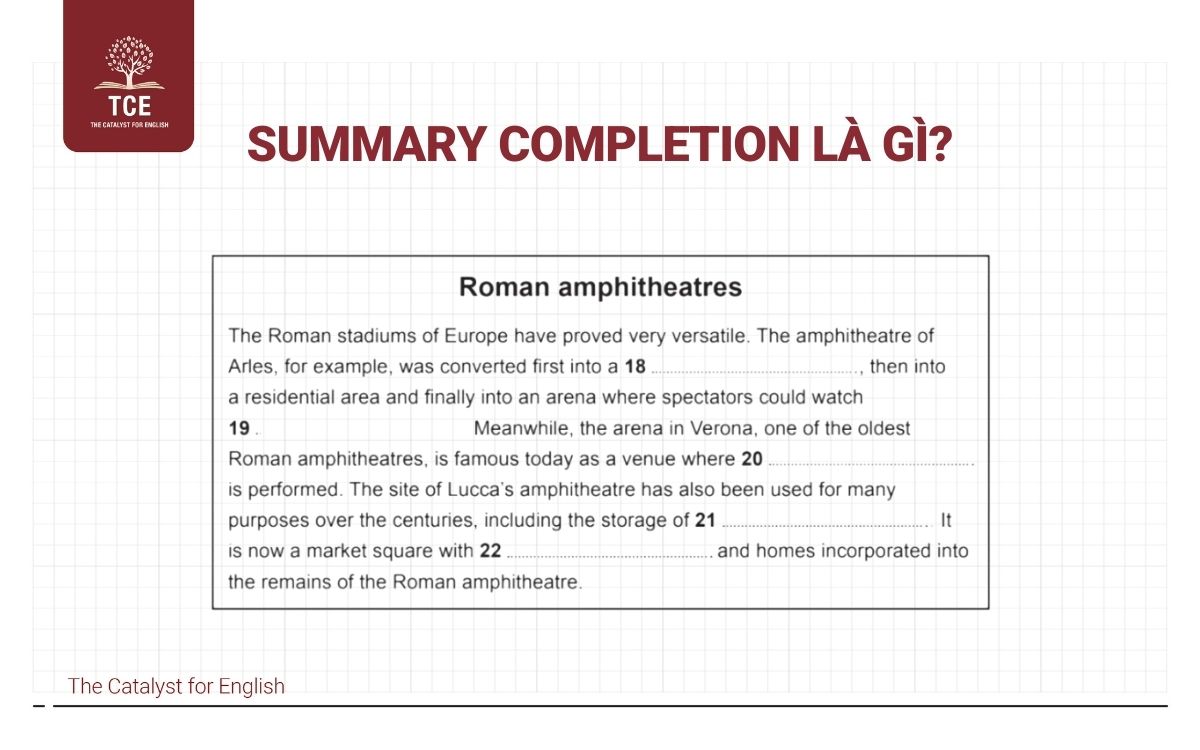
Summary Completion là gì?
Dạng bài Summary Completion sẽ yêu cầu thí sinh hoàn thành một đoạn tóm tắt (summary) bằng cách điền các từ còn thiếu. Tóm tắt này thường dựa trên nội dung của một phần hoặc toàn bộ bài đọc. Người đọc cần phải tìm thông tin trong bài đọc và điền vào chỗ trống với:
Ngoài việc trau dồi từ vựng cho kỹ năng Viết, bạn cũng nên nắm rõ các dạng câu hỏi trong kỹ năng Đọc như Multiple Choice là gì, giúp cải thiện khả năng chọn đáp án chính xác.
Như đã phân tích ở trên, chúng ta chia Summary Completion thành 2 loại:
Dạng 1: Không có danh sách từ
Dưới đây là dạng bài Summary Completion IELTS Reading không có danh sách từ, và đề bài yêu cầu chỉ được điền 1 từ “ONE WORD ONLY”. Các bạn hãy chú ý đọc kỹ yêu cầu này trước khi làm bài nhé.
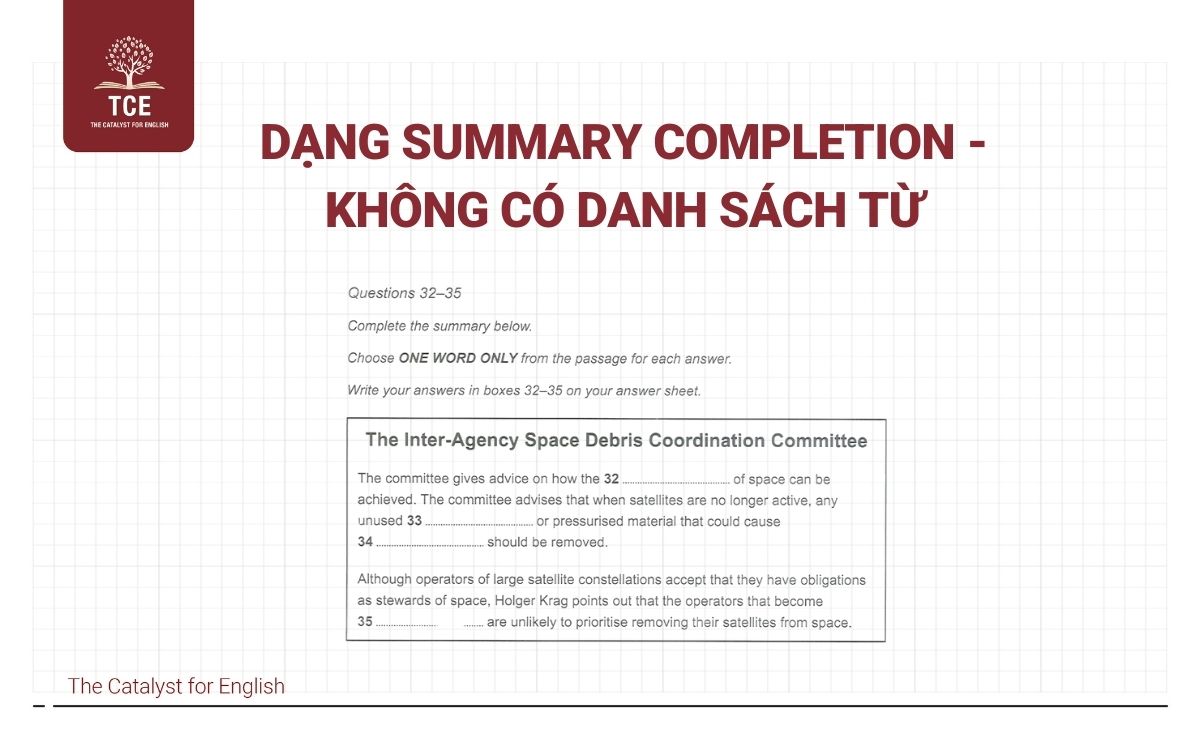
Dạng summary completion không có danh sách từ
(Cam 18- Test 1 – Passage 3)
Dạng 2: Có danh sách từ
Dưới đây là ví dụ dạng bài Summary Completion IELTS Reading có danh sách từ. Với dạng bài này các bạn nhớ sử dụng chữ cái trước các từ để điền vào chỗ trống nhé.
(Cam 18 – Test 2 – Passage 3)
Dù là được cung cấp một danh sách từ, hay là thí sinh cần tự tìm từ trong bài đọc để điền, thì các bước để xử lý dạng bài Summary Completion là giống nhau. Dưới đây TCE sẽ đi cùng các bạn từng bước để xử lí bài Summary Completion IELTS Reading câu hỏi 24-26 từ đề Cam 18 – Test 2 – Passage 3.
Thông thường, dạng bài Summary Completion sẽ là loại câu hỏi xuất hiện thứ 2 hoặc cuối cùng trong một bài đọc. Do vậy trước khi đặt bút làm dạng bài này, các bạn đã nắm được khái quát nội dung chính. Điều này có thể là một nhược điểm khi luyện tập riêng biệt từng dạng bài bởi sẽ mất nhiều thời gian hơn để xác định vị trí thông tin.
Tuy vậy, chúng ta hãy cùng nhau xử lí đề bài dưới đây với câu hỏi Summary Completion nhé.
Living with artificial intelligence
Question 24 – 26:
Complete the summary using the list of phrases, A-F, below
Write the correct letter, A-F, in boxes 24-26 on your answer sheet
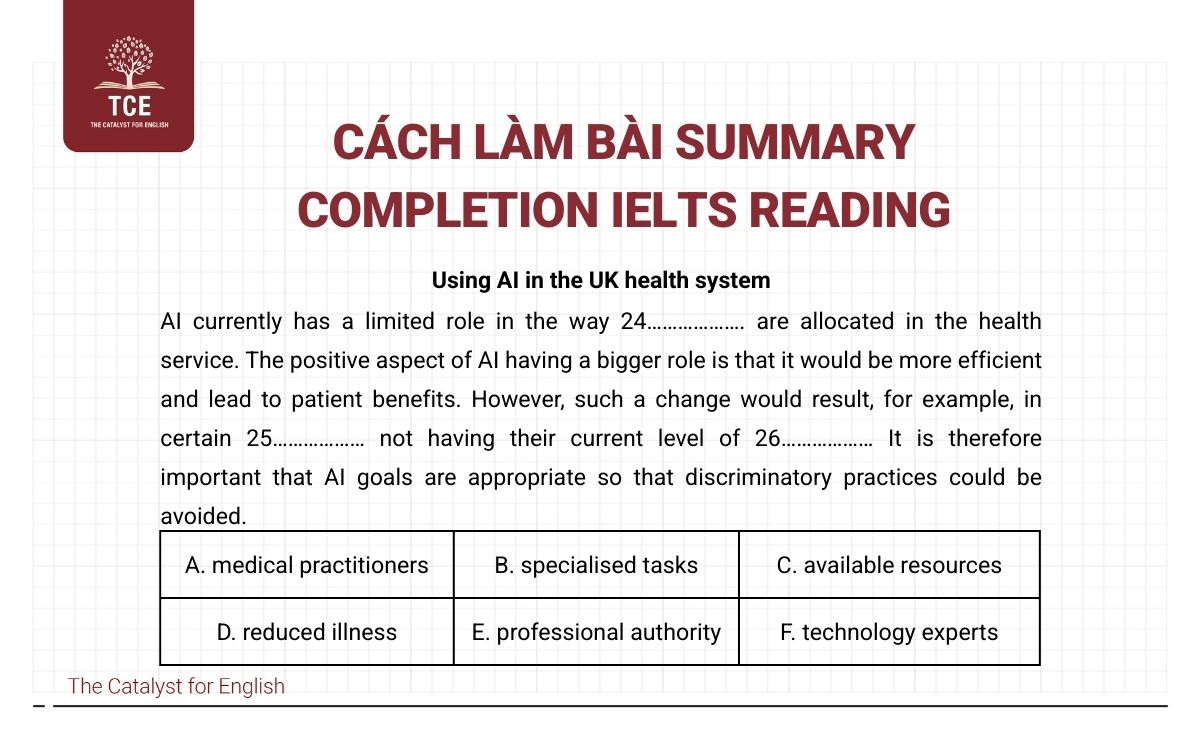
Cách làm bài dạng Summary Completion IELTS Reading
Using AI in the UK health system
AI currently has a limited role in the way 24………………. are allocated in the health service. The positive aspect of AI having a bigger role is that it would be more efficient and lead to patient benefits. However, such a change would result, for example, in certain 25……………… not having their current level of 26……………… It is therefore important that AI goals are appropriate so that discriminatory practices could be avoided.
| A. medical practitioners | B. specialised tasks | C. available resources |
| D. reduced illness | E. professional authority | F. technology experts |
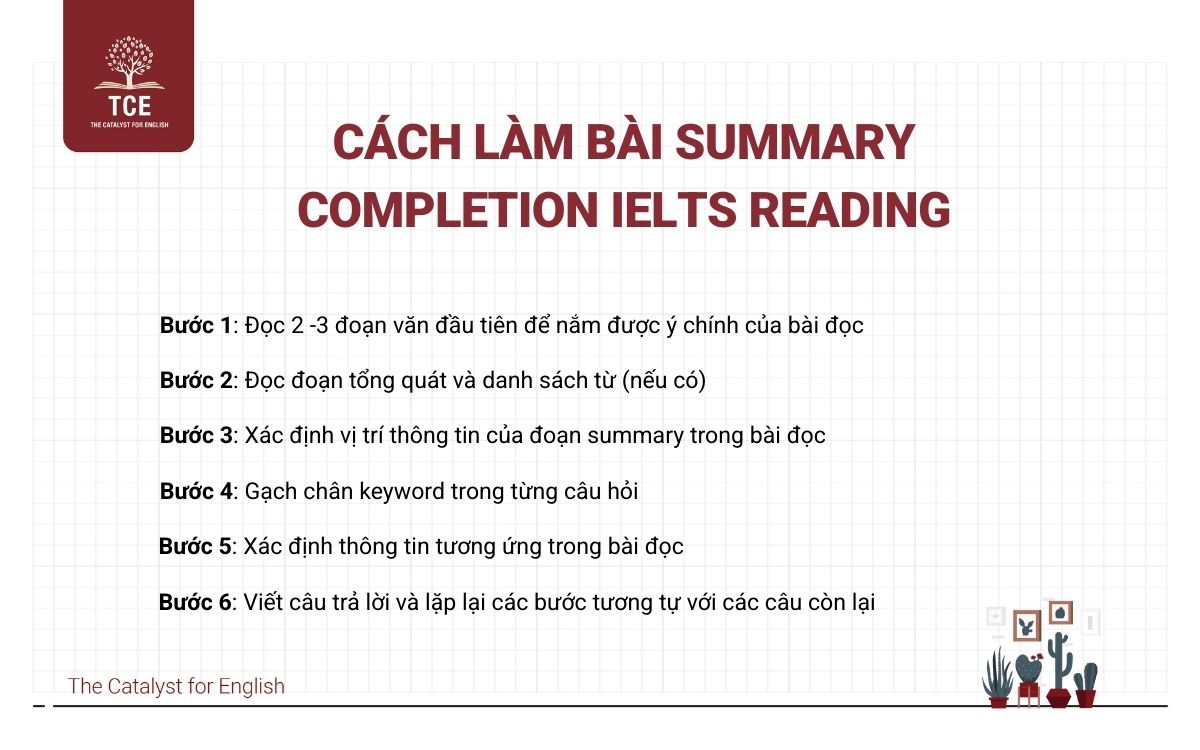
Các bước làm Summary Completion IELTS Reading
Bước 1: Đọc 2 -3 đoạn văn đầu tiên để nắm được ý chính của bài đọc
Các bạn sử dụng phương pháp đọc Skimming để lấy ý chính bằng cách đọc lướt các câu đầu và câu cuối của đoạn văn.
Với đoạn văn đầu tiên:
Powerful artificial intelligence (AI) needs to be reliably aligned with human values, but does this mean AI will eventually have to police those values? This has been the decade of AI, with one astonishing feat after another. A chess-playing AI that can defeat not only all human chess players, but also all previous human-programmed chess machines, after learning the game in just four hours? That’s yesterday’s news, what’s next? True, these prodigious accomplishments are all in so-called narrow AI, where machines perform highly specialised tasks. But many experts believe this restriction is very temporary. By mid-century, we may have artificial general intelligence (AGI) — machines that can achieve human-level performance on the full range of tasks that we ourselves can tackle.
Những câu mà TCE in đỏ Những câu chứa nội dung chính của đoạn.
Như vậy ta xác định được nội dung chính đoạn A: AI đang phát triển nhanh chóng và có thể đạt đến trí tuệ nhân tạo tổng quát (AGI).
Tương tự với đoạn B-L, ta có thể rút ra các thông tin chính sau:
B: Máy móc sẽ vượt qua giới hạn vật lý của con người trong việc xử lý thông tin.
C: AI mang lại lợi ích, tuy nhiên con người cần thận trọng.
Và hãy kết hợp học các dạng bài khác trong IELTS Reading như Matching Heading để nâng cao khả năng nhận diện ý chính và phân tích biểu đồ thông tin hiệu quả hơn.
Bước 2: Đọc đoạn tổng quát và danh sách từ (nếu có)
Đọc kĩ đoạn summary để xác định nội dung chính, và danh sách từ cần điền. Gạch chân các keyword chính trong đoạn, nên ưu tiên các keyword là tiên riêng như UK
Ở trong bài, đoạn tổng quát nói về việc sử dụn`g AI trong hệ thống y tế của Anh
Bước 3: Xác định vị trí thông tin của đoạn summary trong bài đọc
Người đọc quay trở lại bài đọc và tìm trong các đoạn văn vừa đọc liệu có đoạn nào chứa keyword là UK hay không.
Nếu không các bạn đọc tiếp các đoạn văn tiếp theo.
Ta thấy đến đoạn I xuất hiện keyword: United Kingdom
Bước 4: Gạch chân keyword trong từng câu hỏi
AI currently has a limited role in the way 24………………. are allocated in the health service.
Bước 5: Xác định thông tin tương ứng trong bài đọc
Thí sinh xác định thông tin tương ứng bằng cách đối chiếu keyword với từ đồng nghĩa trong bài đọc.
| Câu hỏi | Câu chứa thông tin |
| AI currently has a limited role in the way 24………………. are allocated in the health service. | AI, for example, has begun to exert influence over resource spending within the National Health Service (NHS) in the United Kingdom |
Bạn cũng nên luyện tập với các dạng câu hỏi True/False/Not Given để nâng cao kỹ năng đọc hiểu chi tiết và xác nhận đúng sai thông tin.
Bước 6: Viết câu trả lời và lặp lại các bước tương tự với các câu còn lại
Vị trí cần điền là danh từ, là cái gì đó được phân bổ, sử dụng => đáp án sẽ là resource
AI currently has a limited role in the way 24……resource…………. are allocated in the health service.
Với dạng bài Summary Completion, TCE cũng muốn đưa tới các bạn một vài lưu ý khi các bạn xử lý dạng bài này
Cuối cùng, dù bạn áp dụng chiến thuật nào cho từng dạng bài cụ thể, tốc độ luôn là yếu tố quyết định. Để tối ưu hóa thời gian và giữ vững tâm lý trong phòng thi, bạn nên trang bị cho mình những chiến lược tăng tốc độ làm bài IELTS Reading một cách toàn diện.
Dưới đây là bài tập vận dụng với dạng bài Summary Completion IELTS Reading.
Bài 1: Dạng 1: Không có danh sách từ (Cam 18: Test 3 – Passage 2)
The steam car
The successes and failures of the Doble brothers and their steam cars
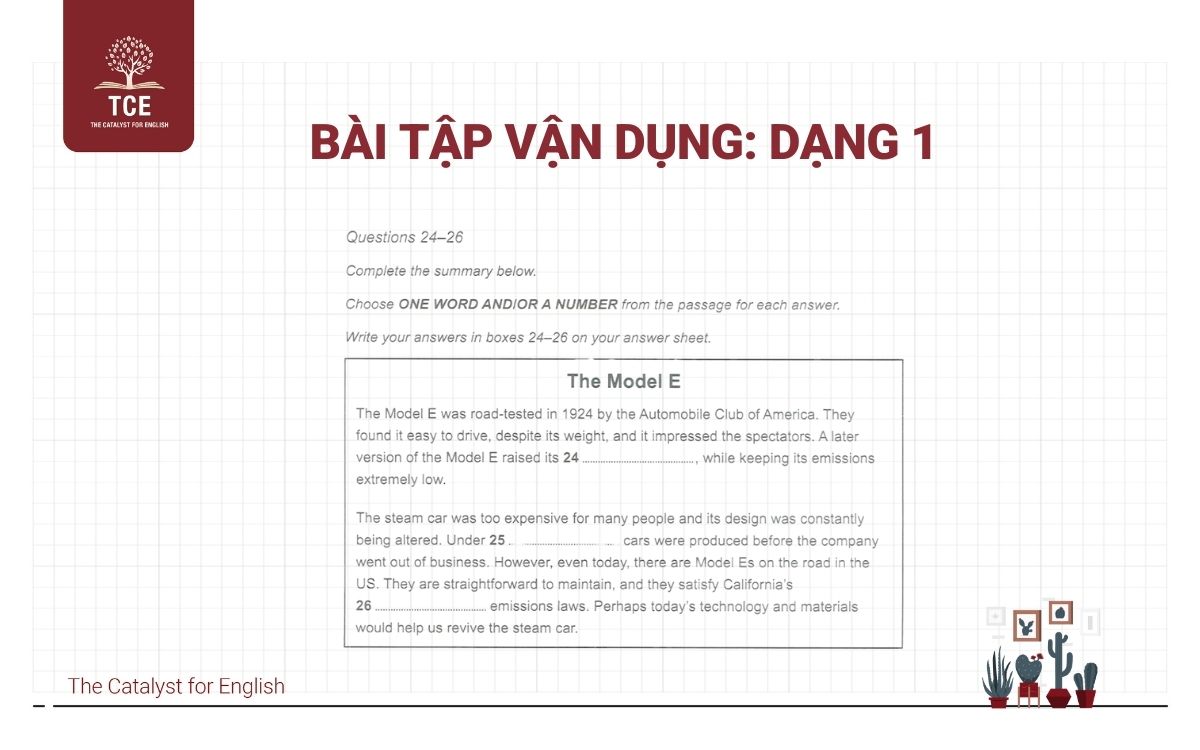
Bài tập vận dụng dạng 1
Bài 2: Dạng 2: Có danh sách từ ( Cam 18 Test 3 – Passage 3)
The case for mixed-ability classes
Picture this scene. It’s an English literature lesson in a UK school, and the teacher has just read an extract from Shakespeare’s Romeo and Juliet with a class of 15-year-olds. He’s given some of the students copies of No Fear Shakespeare, a kid-friendly translation of the original. For three students, even these literacy demands are beyond them. Another girl simply can’t focus and he gives her pens and paper to draw with. The teacher can ask the No Fear group to identify the key characters and maybe provide a tentative plot summary. He can ask most of the class about character development, and five of them might be able to support their statements with textual evidence. Now two curious students are wondering whether Shakespeare advocates living a life of moderation or one of passionate engagement.
As a teacher myself, I’d think my lesson would be going rather well if the discussion went as described above. But wouldn’t this kind of class work better if there weren’t such a huge gap between the top and the bottom? If we put all the kids who needed literacy support into one class, and all the students who want to discuss the virtue of moderation into another?
The practice of ‘streaming’, or ‘tracking’, involves separating students into classes depending on their diagnosed levels of attainment. At a macro level, it requires the establishment of academically selective schools for the brightest students, and comprehensive schools for the rest. Within schools, it means selecting students into a ‘stream’ of general ability, or ‘sets’ of subject specific ability. The practice is intuitively appealing to almost every stakeholder.
I have heard the mixed-ability model attacked by way of analogy: a group hike. The fittest in the group take the lead and set a brisk pace, only to have to stop and wait every 20 minutes. This is frustrating, and their enthusiasm wanes. Meanwhile, the slowest ones are not only embarrassed but physically struggling to keep up. What’s worse, they never get a long enough break. They honestly just want to quit. Hiking, they feel, is not for them.
Mixed-ability classes bore students, frustrate parents and burn out teachers. The brightest ones will never summit Mount Qomolangma, and the stragglers won’t enjoy the lovely stroll in the park they are perhaps more suited to. Individuals suffer at the demands of the collective, mediocrity prevails. So: is learning like hiking?
The current pedagogical paradigm is arguably that of constructivism, which emerged out of the work of psychologist Lev Vygotsky. In the 1930s, Vygotsky emphasised the importance of targeting a student’s specific ‘zone of proximal development’ (ZPD). This is the gap between what they can achieve only with support- teachers, textbooks, worked examples, parents and so on – and what they can achieve independently. The purpose of teaching is to provide and then gradually remove this ‘scaffolding’ until they are autonomous (Q30). If we accept this model, it follows that streaming students with similar ZPDs would be an efficient and effective solution. And that forcing everyone on the same hike – regardless of aptitude – would be madness.
Despite all this, there is limited empirical evidence to suggest that streaming results in better outcomes for students. Professor John Hattie, director of the Melbourne Education Research Institute, notes that tracking has minimal effects on learning outcomes. What is more, streaming appears to significantly – and negatively – affect those students assigned to the lowest sets. These students tend to have much higher representation of low socioeconomic class. Less significant is the small benefit for those lucky clever students in the higher sets. The overall result is that the smart stay smart and the dumb get dumber, further entrenching the social divide.
In the latest update of Hattie’s influential meta-analysis of factors influencing student achievement, one of the most significant factors is the teachers’ estimate of achievement. Streaming students by diagnosed achievement automatically limits what the teacher feels the student is capable of. Meanwhile, in a mixed environment, teachers’ estimates need to be more diverse and flexible.
While streaming might seem to help teachers effectively target a student’s ZPD, it can underestimate the importance of peer-to-peer learning. A crucial aspect of constructivist theory is the role of the MKO – ‘more knowledgeable other’ – in knowledge construction. While teachers are traditionally the MKOs in classrooms, the value of knowledgeable student peers must not go unrecognized either.
I find it amazing to watch students get over an idea to their peers in ways that I would never think of. They operate with different language tools and different social tools from teachers and, having just learned it themselves, they possess similar cognitive structures to their struggling classmates. There is also something exciting about passing on skills and knowledge that you yourself have just mastered – a certain pride and zeal, a certain freshness to the interaction between ‘teacher’ and ‘learner’ that is often lost by the expert for whom the steps are obvious and the joy of discovery forgotten.
Having a variety of different abilities in a collaborative learning environment provides valuable resources for helping students meet their learning needs, not to mention improving their communication and social skills. And today, more than ever, we need the many to flourish – not suffer at the expense of a few bright stars. Once a year, I go on a hike with my class, a mixed bunch of students. It is challenging. The fittest students realize they need to encourage the reluctant. There are lookouts who report back, and extra items to carry for others. We make it – together.
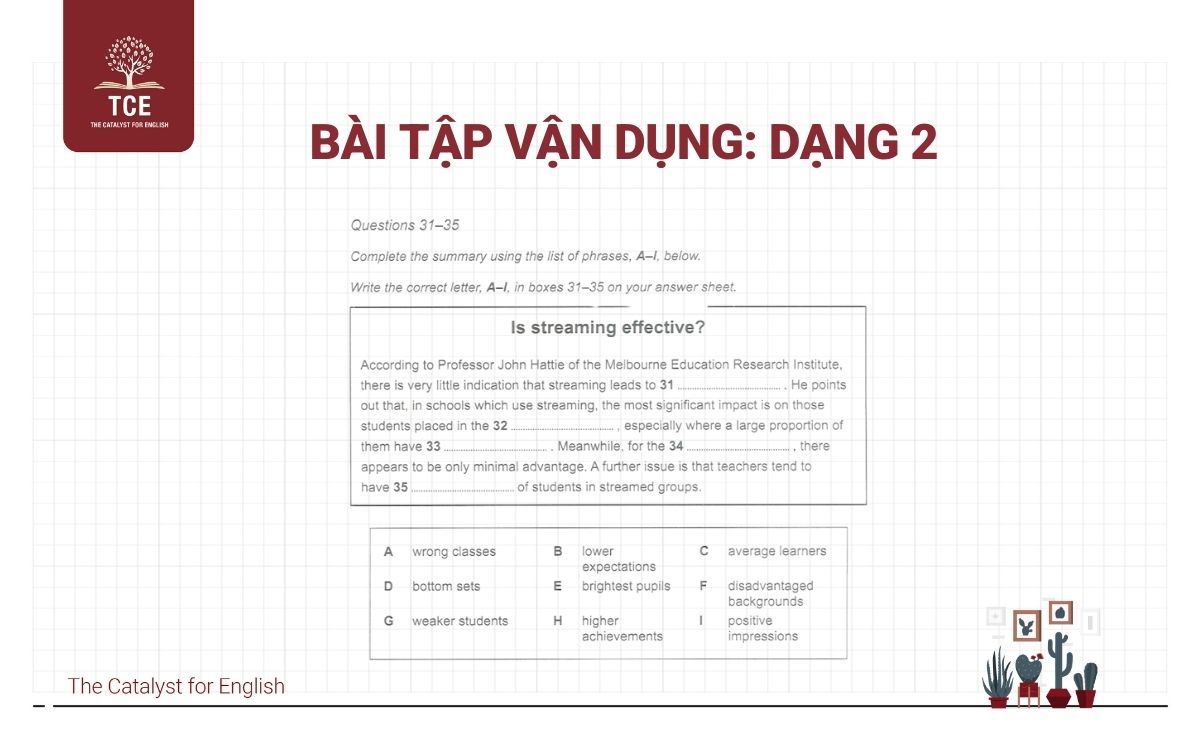
Bài vận dụng dạng 2
Đáp án:
Bài 1:
| Câu | Đáp án |
| 24 | speed |
| 25 | fifty/50 |
| 26 | strict |
Bài 2:
| Câu | Đáp án |
| 31 | H |
| 32 | D |
| 33 | F |
| 34 | E |
| 35 | B |
Nắm vững lý thuyết là bước đầu, nhưng để biến kiến thức thành điểm số, bạn cần một lộ trình luyện tập bài bản và sự dẫn dắt từ đội ngũ giảng viên 8.0+ Overall. Nếu bạn muốn chinh phục band điểm Reading mơ ước với chiến lược cá nhân hóa, hãy khám phá ngay Khóa học IELTS tại The Catalyst – nơi cung cấp cho bạn phương pháp độc quyền và sự hỗ trợ toàn diện.
Bạn đã sẵn sàng áp dụng những kỹ năng vừa học vào điều kiện thi thật? Đừng để sự bỡ ngỡ trong phòng thi ảnh hưởng đến kết quả. Hãy trải nghiệm ngay kỳ thi thử IELTS chuẩn format chuẩn theo bài thi thật tại The Catalyst để đánh giá chính xác trình độ, làm quen với áp lực thời gian và nhận feedback chi tiết từ chuyên gia.
Như vậy TCE đã cùng bạn đi qua các bước để xử lý dạng bài Summary Completion IELTS Reading. Ngoài các bước và kỹ thuật làm bài, một yếu tố quan trọng giúp bạn đạt được điểm cao phần thi Reading là có một vốn từ vựng rộng và kiến thức ngữ pháp chắc chắn. Vì vậy các bạn hãy cố gắng trau dồi thêm vốn từ vựng của mình mỗi ngày ngoài luyện tập nhé. Và để củng cố kỹ năng toàn diện, bạn có thể tiếp tục khám phá thêm các dạng bài và cách thức làm bài trong danh mục IELTS Reading của TCE.